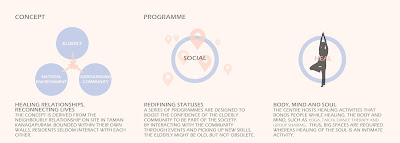DESIGN STUDIO 4C: A CENTRE FOR THE ELDERLY
The project calls for a design of an elderly center in a suburban area with some complexity that includes the complexity of site topography and vegetation and socio-cultural events. Students are required to provide full design proposal incorporating precedent study and site analysis at appropriate level of presentation. It explores design solution that harness environmental qualities and conditions for human and environment sustainability. Students explore design solutions that reduce environmental impact utilizing clustered spatial typology and passive energy. The design should contribute to and merge harmoniously with nature and the site, and provide the best of experiences for the users.
The objectives of this project are as follow:
- To develop awareness of environmental sustainability in architectural design
- To develop the student’s ability to meet the imperative and inter-related environmental and social needs, as well as make poetry with the buildings
- To emphasize on space planning of clusters of building
Learning Outcomes
- Apply ideas of environmental sustainability in design
- Design and create architectural spaces with consideration of environmental poetics in relation to the basic natural context and existing built context which impact on users’ experiences
- Combine the environmental needs, the site (site topography, history and socio-cultural events), and the users’ experiences within simple building design in the open landscape/suburban context.
- Produce drawings (both 2D and 3D), modelling and verbal presentation to communicate and visualize architectural design and ideas based on clustered spatial typology
Brief
In the coming years, a greater proportion of houses, apartments and institutional accommodations will be built for elderly persons than at any previous time in our history. There are several reasons for this. Among them are; firstly is the fact that the life-span of mankind has increased through advances in medical and science; thus the proportion of older people in the population has increased. Secondly, with the passing of the three-generation household, more elderly person are living by themselves and therefore require separate housing accommodations. Ordinary design criteria do not always apply to housing for the aged. One of the most striking differences is the high concentration of one- and two-person families as a result of children leaving home or the death of one spouse. Also important are the needs caused by physical deterioration in old age, which requires special design treatments and facilities. In addition, certain basic psychological and sociological principles should be observed in planning for the elderly. People in this age group usually do not want to break their ties with family and neighborhood and be placed in a new and foreign environment. They need activities, not merely 3 hobbies, and they want to participate in community functions. The objectives, programs, and physical facilities for the housing of the aged should encourage and support the continuance of earlier patterns of living, daily routines, personal care habits, social contracts, and recreational activities. An important objective is to maintain independent living as long as possible. Thus, this project aims to provide a design for a center for the Elderly in Subang Jaya, Selangor. Subang Jaya, a fast developing suburban area, is considered a suitable site for the project due to its fast growing population and its establishment as ‘an old neighborhoods’ where many of the aged are likely to be living and to have their roots
Concept Diagrams
Development Diagrams
Plans | Elevations | Sections
Renders
 |
| cafe | a space to share |
 |
| library | a space to learn |
 |
| office | a space to connect |
 |
| yoga room | a space to heal |
 |
| break out space | a space to share |
 |
| courtyard | a space to mingle |













Comments
Post a Comment